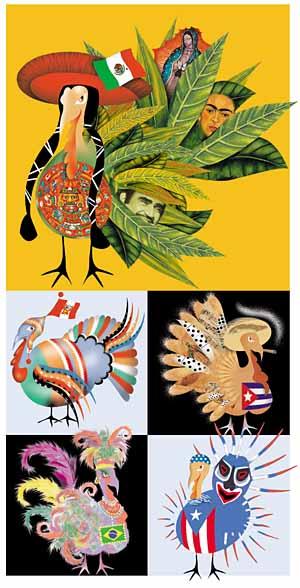|
 |
|
Esta página no está disponible en español. THE MIAMI HERALDThe All-Americas Turkey: From Puerto Rican Achiote Dressing To Cuban Sour-Orange Marinade, The World's Richest Turkey Traditions Surround UsBY KATHY MARTIN
November 21, 2002
Wild turkey was on the menu at what's considered the first Thanksgiving in Plymouth, Mass., in 1621. A century and a half later, Benjamin Franklin extolled it as ``a true original native of America.'' The turkey's origins, however, are not on the rocky coast of New England but in the tropical heart of Mesoamerica, the pre-Columbian domain of the Maya in what's now Central America and Mexico. Perhaps 1,800 years before the Pilgrims hunted wild turkey, the Maya domesticated the bird, serving it to their elite and using it in ceremonies for healing, planting and praying for rain, according to food historian Sophie D. Coe. The Aztec also raised turkeys, Coe writes in her fascinating America's First Cuisines (Texas, 1994). She quotes 16th century Franciscan missionary Bernardino de Sahagún's four-star review: ``It leads the meats; it is the master. It is tasty, fat, savory.'' Like tomatoes, peppers, potatoes, chocolate and corn, turkeys were loaded onto Spanish galleons and carried back to the mother country. Soon, the king of Spain decreed that every returning ship was to bring back 10 turkeys, Coe reports, five male and five female. ''It was one of the most rapid successes as far as the adoption of New World foodstuffs goes,'' she writes, ``speedily replacing the tough, stringy peacock as a spectacular dish for banquets.'' Turkey was a popular feast food in Meso and Latin America, too, but there it was ''cut up in pieces and cooked in sauces en cazuela'' -- in a stew pot, explains Marisel E. Presilla, a New Jersey-based culinary scholar and author. ''The roasting of the turkey is European -- roasting a big whole animal and bringing it to the table with pomp and ceremony,'' Presilla says. So when the Pilgrims bagged American turkeys, whose ancestors hailed from the central Mexican plateau, they knew how to roast them because of the turkey trend that swept Europe after the Spanish began importing the big bird -- from Mexico. The dizzying acculturation didn't stop there, as reflected in our recipes: • Turkey With Puerto Rican Flavors: Adapted from chef Patricia L. Wilson of Johnson & Wales University, this bird is distinguished by its brilliant red-gold color. The secret is achiote seeds, produced by the annatto tree and used by indigenous Caribbean peoples to make body paint. Spanish settlers adopted it as a cheap substitute for saffron. The sweet plantain-based dressing is spiked with rum and accented with salty, crunchy bits of fried salt pork. • Cuban-Style Roast Turkey: Linda Cicero, our Cook's Corner columnist, adapted this recipe years ago from Herald writer Ana Veciana-Suarez, and still considers it a favorite. The sour-orange baste and bacon wrap show how Spanish imports (orange seeds and pigs arrived with Columbus) can enhance this all-Americas bird. • Mamá's Turkey Stuffing: The chestnuts in this dish are decidedly European, the cooking ham quite Cuban. Miami Beach author Mimi O'Higgins writes in A Taste of Old Cuba that the subtle and sophisticated dish was typical of her mother, ``its delicacy reminiscent of her quiet dignity.'' • Easy Turkey Mole: Linda Bladholm, our Ethnic Explorer columnist, adapted this recipe from one the legendary James Beard shared with House & Garden magazine readers in 1965. She found that with a few readily available ingredients, Beard created a remarkably authentic mole poblano, the complex chile, chocolate and ground nut sauce that is a classic example of Latin American en cazuela cooking. • Pork and Fruit Stuffing: Latin food expert Elisabeth Lambert Ortiz provides no background about this dish in her Complete Book of Mexican Cooking, but we loved its lively combination of sweet fruit, hot peppers and savory pork. • Ceia de Natal (Holiday Turkey): A more accurate translation is Christmas turkey, and that is what it was for Sheila Thomson (nee Goncalves da Silva) growing up in the Brazilian state Rio Grande do Sul. Thomson, of Miami Beach, shares it and much more on her website, www.maria-brazil.org. The manioc meal is typically Brazilian, as is the combination of fruit and meat. The peaches reflect a long-ago time when newly available canned fruits were considered the height of elegance in Latin America. • Pisco-Spiked Bread Stuffing: The hot peppers and potent pisco are obvious Peruvian touches in this recipe from The Art of South American Cooking. Its author, the late Felipe Rojas-Lombardi, was a native of Peru and a highly regarded chef in New York in the 1980s. Rojas-Lombardi was a mentor and friend to Presilla, who recalls, ``He loved Thanksgiving.'' As do we all.
|

 Most of us think of the turkey as an all-American bird, but few of us appreciate how deeply American it is or what a convoluted journey it took to our holiday tables.
Most of us think of the turkey as an all-American bird, but few of us appreciate how deeply American it is or what a convoluted journey it took to our holiday tables.